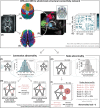Focal to bilateral tonic-clonic seizures are associated with widespread network abnormality in temporal lobe epilepsy
- PMID: 33476430
- PMCID: PMC8600951
- DOI: 10.1111/epi.16819
Focal to bilateral tonic-clonic seizures are associated with widespread network abnormality in temporal lobe epilepsy
Abstract
Objective: Our objective was to identify whether the whole-brain structural network alterations in patients with temporal lobe epilepsy (TLE) and focal to bilateral tonic-clonic seizures (FBTCS) differ from alterations in patients without FBTCS.
Methods: We dichotomized a cohort of 83 drug-resistant patients with TLE into those with and without FBTCS and compared each group to 29 healthy controls. For each subject, we used diffusion-weighted magnetic resonance imaging to construct whole-brain structural networks. First, we measured the extent of alterations by performing FBTCS-negative (FBTCS-) versus control and FBTCS-positive (FBTCS+) versus control comparisons, thereby delineating altered subnetworks of the whole-brain structural network. Second, by standardizing each patient's networks using control networks, we measured the subject-specific abnormality at every brain region in the network, thereby quantifying the spatial localization and the amount of abnormality in every patient.
Results: Both FBTCS+ and FBTCS- patient groups had altered subnetworks with reduced fractional anisotropy and increased mean diffusivity compared to controls. The altered subnetwork in FBTCS+ patients was more widespread than in FBTCS- patients (441 connections altered at t > 3, p < .001 in FBTCS+ compared to 21 connections altered at t > 3, p = .01 in FBTCS-). Significantly greater abnormalities-aggregated over the entire brain network as well as assessed at the resolution of individual brain areas-were present in FBTCS+ patients (p < .001, d = .82, 95% confidence interval = .32-1.3). In contrast, the fewer abnormalities present in FBTCS- patients were mainly localized to the temporal and frontal areas.
Significance: The whole-brain structural network is altered to a greater and more widespread extent in patients with TLE and FBTCS. We suggest that these abnormal networks may serve as an underlying structural basis or consequence of the greater seizure spread observed in FBTCS.
Keywords: connectome; diffusion MRI; drug-resistant epilepsy; network abnormality; node abnormality; secondary generalized seizures.
© 2021 The Authors. Epilepsia published by Wiley Periodicals LLC on behalf of International League Against Epilepsy.
Conflict of interest statement
None of the authors has any conflict of interest to disclose.
Figures




Similar articles
-
Changes in topological properties of brain structural covariance networks and alertness in temporal lobe epilepsy with and without focal to bilateral tonic-clonic seizures.Neuroreport. 2025 May 14;36(8):421-434. doi: 10.1097/WNR.0000000000002164. Epub 2025 May 7. Neuroreport. 2025. PMID: 40242961
-
Altered structural network in temporal lobe epilepsy with focal to bilateral tonic-clonic seizures.Ann Clin Transl Neurol. 2024 Sep;11(9):2277-2288. doi: 10.1002/acn3.52135. Epub 2024 Aug 16. Ann Clin Transl Neurol. 2024. PMID: 39152643 Free PMC article.
-
A study of brain functional network and alertness changes in temporal lobe epilepsy with and without focal to bilateral tonic-clonic seizures.BMC Neurol. 2022 Jan 7;22(1):14. doi: 10.1186/s12883-021-02525-w. BMC Neurol. 2022. PMID: 34996377 Free PMC article.
-
Neuroimaging correlates of language network impairment and reorganization in temporal lobe epilepsy.Brain Lang. 2019 Jun;193:31-44. doi: 10.1016/j.bandl.2016.06.002. Epub 2016 Jul 5. Brain Lang. 2019. PMID: 27393391 Free PMC article. Review.
-
Graph theory findings in the pathophysiology of temporal lobe epilepsy.Clin Neurophysiol. 2014 Jul;125(7):1295-305. doi: 10.1016/j.clinph.2014.04.004. Epub 2014 Apr 21. Clin Neurophysiol. 2014. PMID: 24831083 Free PMC article. Review.
Cited by
-
Cenobamate as an Early Adjunctive Treatment in Drug-Resistant Focal-Onset Seizures: An Observational Cohort Study.CNS Drugs. 2024 Sep;38(9):733-742. doi: 10.1007/s40263-024-01109-9. Epub 2024 Aug 3. CNS Drugs. 2024. PMID: 39096467 Free PMC article.
-
Ictogenesis proceeds through discrete phases in hippocampal CA1 seizures in mice.Nat Commun. 2023 Sep 26;14(1):6010. doi: 10.1038/s41467-023-41711-x. Nat Commun. 2023. PMID: 37752179 Free PMC article.
-
Structural connectivity changes in focal epilepsy: Beyond the epileptogenic zone.Epilepsia. 2025 Jan;66(1):226-239. doi: 10.1111/epi.18175. Epub 2024 Nov 22. Epilepsia. 2025. PMID: 39576226 Free PMC article.
-
Evaluation of limbic microstructural abnormalities in temporal lobe epilepsy: A neurite orientation distribution and density imaging study.Epilepsia. 2025 Jun 4:10.1111/epi.18488. doi: 10.1111/epi.18488. Online ahead of print. Epilepsia. 2025. PMID: 40465169
-
White matter alterations in focal to bilateral tonic-clonic seizures.Front Neurol. 2022 Sep 14;13:972590. doi: 10.3389/fneur.2022.972590. eCollection 2022. Front Neurol. 2022. PMID: 36188403 Free PMC article.
References
-
- Jobst BC, Williamson PD, Neuschwander TB, Darcey TM, Thadani VM, Roberts DW. Secondarily generalized seizures in mesial temporal epilepsy: clinical characteristics, lateralizing signs, and association with sleep‐wake cycle. Epilepsia. 2001;42:1279–87. - PubMed
-
- Lawn ND, Bamlet WR, Radhakrishnan K, O’Brien PC, So EL. Injuries due to seizures in persons with epilepsy: a population‐based study. Neurology. 2004;63:1565–70. - PubMed
-
- Devinsky O, Hesdorffer DC, Thurman DJ, Lhatoo S, Richerson G. Sudden unexpected death in epilepsy: epidemiology, mechanisms, and prevention. Lancet Neurol. 2016;15:1075–88. - PubMed
-
- Harden C, Tomson T, Gloss D, Buchhalter J, Cross JH, Donner E, et al. Practice guideline summary: sudden unexpected death in epilepsy incidence rates and risk factors: report of the Guideline Development, Dissemination, and Implementation Subcommittee of the American Academy of Neurology and the American Epilepsy Society. Neurology. 2017;88:1674–80. - PubMed
Publication types
MeSH terms
Grants and funding
LinkOut - more resources
Full Text Sources
Other Literature Sources
Medical

